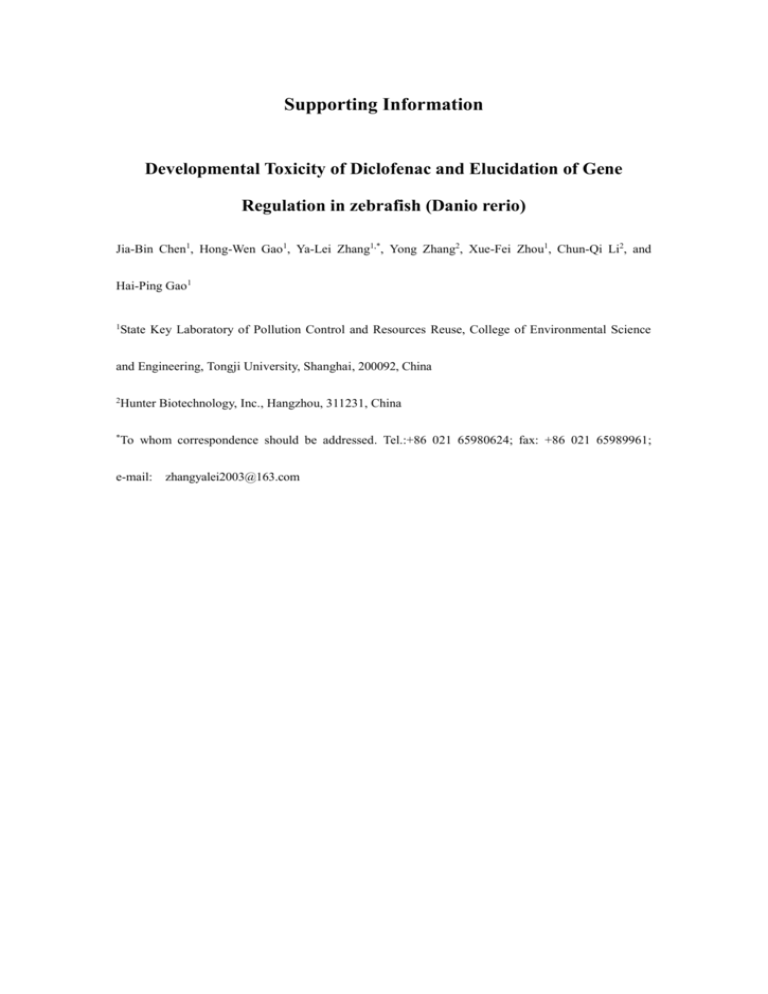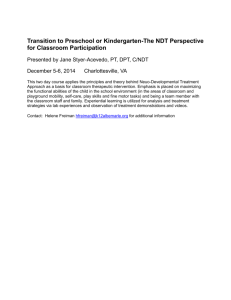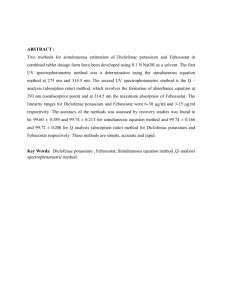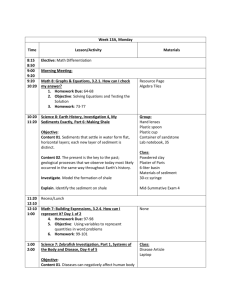srep04841-s1
advertisement

Supporting Information Developmental Toxicity of Diclofenac and Elucidation of Gene Regulation in zebrafish (Danio rerio) Jia-Bin Chen1, Hong-Wen Gao1, Ya-Lei Zhang1,*, Yong Zhang2, Xue-Fei Zhou1, Chun-Qi Li2, and Hai-Ping Gao1 1 State Key Laboratory of Pollution Control and Resources Reuse, College of Environmental Science and Engineering, Tongji University, Shanghai, 200092, China 2 Hunter Biotechnology, Inc., Hangzhou, 311231, China * To whom correspondence should be addressed. Tel.:+86 021 65980624; fax: +86 021 65989961; e-mail: zhangyalei2003@163.com Tests Test S1. Determination of diclofenac by HPLC-UV. Test S2. Determination of diclofenac in the cytoplasm and membrane by HPLC-MS/MS. Test S1. Determination of diclofenac by HPLC-UV. Diclofenac was determined on a high performance liquid chromatography (HPLC) with a UV detector. The Kromasil ODS C18 (250×4.6 mm, 5 μm) was used as the LC column for separation. The mobile phase was composed of 60% acetonitrile and 40% water with 0.4% acetic acid. The flow rate was 1 ml·min-1, and the detection wavelength was set at 280 nm. The calibration curve and chromatogram were shown in Fig. S1. The limit of detection (LOD) for diclofenac was 0.13 μM, which was determined as the concentration of diclofenac giving a signal to noise ratio greater than 3:1. Test S2. Determination of diclofenac in the cytoplasm and membrane by HPLC-MS/MS. The concentrations of diclofenac in the cytoplasm and membrane were determined by UPLC-MS/MS1. Briefly, LC analysis was conducted on Thermo Accela UPLC equipped with a zorbax extend-C18 column (100×2.1 mm, 1.8 μm). The mobile phase consisted of a binary mixture of solvents A (0.4% acetic acid in water) and B (acetonitrile) with the flow rate of 0.2 ml·min-1. The gradient was performed by increasing the content of B from 38% at 1 min, then increased to 60% at 12 min, finally back to 38% at 17-20 min. MS analysis was performed on a TSQ Quantum Access triple quadrupole mass spectrometer in the negative ion electro spray mode. The sheath gas pressure and AUX gas pressure were 40 and 10 Arb, respectively. The spray voltage and skimmer offset were set at 3500 and 10 V, respectively. The collision voltage was 20 eV. The daughter ion of m/z 214 was used for detection and quantification and the other one of m/z 250 for confirmation. Series of diclofenac standard solutions (0.016, 0.063, 0.157. 0.314, 0.943, and 3.145 μM) were prepared for the determination of calibration curve. Good linearity of the calibration curve was observed with R2 being 0.9996. LOD (S/N=3) for diclofenac was determined to be 0.0007 μM. Tables Table S1. Concentration and purity of total RNA. Table S2. Parameters of gene primers. Table S3. Mortality of embryos at different exposed time. Table S4. Percentage of zebrafish with developmental abnormality during the exposure at 4 dpt. Table S1. Concentration and purity of total RNA. time Concentration (μM) A260 0 3.38 10.13 15.2 0 3.38 10.13 15.2 0.124 0.100 0.102 0.097 0.126 0.146 0.111 0.108 1 dpt 2 dpt A280 RNA concentration (μg/ml) A260/A280 0.074 0.058 0.062 0.059 0.076 0.09 0.068 0.065 1.49 1.20 1.22 1.16 1.51 1.75 1.33 1.30 1.68 1.72 1.65 1.64 1.66 1.62 1.63 1.66 Table S2. Parameters of gene primers. Gene β-actin Gata4 Nkx2.5 Wnt3a Wnt8a Function Reference gene Development of heart and intestine Development of heart Development of heart and body axis Development of body axis and tail Tm Best cycle Product length (℃) number (bp) 60 30 389 57.5 38 286 51 38 281 56 38 198 59 40 334 Primers Forward 5’-CATCAGCATGGCTTCTGCTCTGTATGG-3’ Reverse 5’-GACTTGTCAGTGTACAGAGACACCCT-3’ Forward 5'-TCCAGGCGGGTGGGTTTATC-3’ Reverse 5'-TGTCTGGTTCAGTCTTGATGGGTC-3’ Forward 5'-GTCCAGGCAACTCGAACTACTC-3’ Reverse 5'-AACATCCCAGCCAAACCATA-3 Forward 5'-TACGCCTTCTTCAAGCATCC-3’ Reverse 5'-CTCTTTGCGCTTTTCTGTCC-3’ Forward 5'-CAAGCAAGGAAGTTGGAGATGG-3’ Reverse 5'-CGCATTTGACTGTGCAGCAC-3’ Table S3. Mortality of embryos at different exposed time. fish water 1.01 μM 3.38 μM 10.13 μM 15.2 μM 1 dpt 0 1 0 0 0 2 dpt 0 0 0 0 0 3 dpt 0 0 0 4 13 4 dpt 0 0 8 26 17 Total 0 1 (3.3%) 8 (26.7%) 30 (100%) 30 (100%) Table S4. Percentage of zebrafish with developmental abnormality during the exposure at 4 dpt. 0 μM 1.01 μM 3.38 μM 10.13 μM 15.2 μM 0 0 100 - - abnormal jaw 0 0 100 - - smaller eye 0 0 100 - - lack of liver 0 0 100 - - lack of intestine 0 0 100 - - 0 0 100 - - 0 0 100 - - 0 0 80 - - 0 0 60 - - 0 0 60 - - pericardial edema shorter body length abnormal muscle and somite abnormal pigmentation lack of circulation body edema -: no data, because all zebrafish were dead in the 10.13 and 15.20 μM treatment groups at 4 dpt. Figures Figure S1. The calibration curve and chromatogram of diclofenac (162 μM). Figure S2. Agarose gel electrophoresis of total RNA extract of zebrafish. Figure S3. Effect of pH (A), ionic strength (B), temperature (C) on the binding number (γ) of diclofenac (81μM) to embryos after 8 h incubation. Figure S4. Distribution of diclofenac (5-162 μM) in different parts (ectracellular, membrane, cytoplasm) of zebrafish embryos. Figure S5. Toxic characteristics of zebrafish related to the eye, muscle, liver, intestine and circulation during the exposure at 4 dpt. (A) Control group; (B) 1.01 μM exposure group; (C) 3.38 μM exposure group Figure S6. Toxic characteristics of zebrafish related to pericardial and body edema during the exposure at 4 dpt. (A) Control group; (B) 1.01 μM exposure group; (C) 3.38 μM exposure group Figure S7. Toxic characteristics of zebrafish related to abnormal pigmentation during the exposure at 4 dpt. (A) Control group; (B) 1.01 μM exposure group; (C) 3.38 μM exposure group Figure S8. Agarose gel electrophoresis of β-actin (a), Wnt3a (b), Wnt8a (c), Gata4 (d) and Nkx2.5 (e) at 1 and 2 dpt. (A) The treatment groups of 0, 3.38,10.13, 15.2 μM; (B) The treatment groups of 0 and 1.01 μM and blank control (supplemental experiments). Figure S9. Full-length blots/gels of Wnt8a 5000 4000 y=3.277x+0.8714, 2 R =0.9999 Aera 3000 2000 1000 0 0 200 400 600 800 1000 1200 1400 1600 Cdiclofenac (μM) Figure S1. The calibration curve and chromatogram of diclofenac (162 μM). Figure S2. Agarose gel electrophoresis of the total RNA extract of zebrafish. 0.60 B A C 0.55 0.50 (nmol/embryo) 0.45 0.40 0.35 0.30 0.25 0.20 0.15 0.10 5 6 7 8 9 10 0.0 0.1 pH 0.2 20 25 30 35 40 o I (M) T ( C) Figure S3. Effect of pH (A), ionic strength (B), temperature (C) on the binding number (γ) of diclofenac (81μM) to embryos after 8 h incubation. 16 Membrane Cytoplasm Extracellular 14 (nmol/embryo) 12 10 8 6 4 2 0 5.0 10.1 20.2 40.5 81.0 162.0 C0 (M) Figure S4. Distribution of diclofenac (5-162 μM) in different parts (extracellular, membrane, cytoplasm) of zebrafish embryos. Figure S5. Toxic characteristics of zebrafish related to the eye, muscle, liver, intestine and circulation during the exposure at 4 dpt. (A) Control group; (B) 1.01 μM exposure group; (C) 3.38 μM exposure group. Figure S6. Toxic characteristics of zebrafish related to pericardial and body edema during the exposure at 4 dpt. (A) Control group; (B) 1.01 μM exposure group; (C) 3.38 μM exposure group Figure S7. Toxic characteristics of zebrafish related to abnormal pigmentation during the exposure at 4 dpt. (A) Control group; (B) 1.01 μM exposure group; (C) 3.38 μM exposure group Figure S8. Agarose gel electrophoresis of β-actin (a), Wnt3a (b), Wnt8a (c), Gata4 (d) and Nkx2.5 (e) at 1 and 2 dpt. (A) The treatment groups of 0, 3.38,10.13, 15.2 μM; (B) The treatment groups of 0, 1.01 μM and blank control (supplemental experiments). Figure S9. Full-length blots/gels of Wnt8a Reference 1. Yuan H, Zhou X, Zhang YL. Degradation of Acid Pharmaceuticals in the UV/H2O2 Process: Effects of Humic Acid and Inorganic Salts. CLEAN – Soil, Air, Water 2013, 41(1): 43-50.







